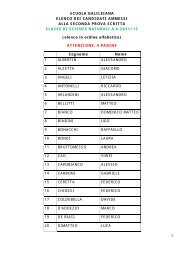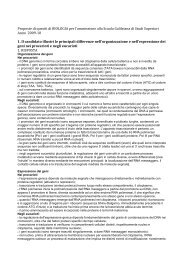Soluzione prova di Matematica - Scuola Galileiana di Studi Superiori
Soluzione prova di Matematica - Scuola Galileiana di Studi Superiori
Soluzione prova di Matematica - Scuola Galileiana di Studi Superiori
You also want an ePaper? Increase the reach of your titles
YUMPU automatically turns print PDFs into web optimized ePapers that Google loves.
4<br />
portando tutto a secondo membro e or<strong>di</strong>nando con le potenze <strong>di</strong> t 2 si ottiene<br />
(2m(am + b) −2mb(1 − m 2 ))t 2 + ((1 − m 2 )b(am + b)+4m 2 b 2 − b(1 − m 2 )(b − ma))t +2mb 2 (b −ma) = 0;<br />
il coefficiente <strong>di</strong> t si semplifica in 2bm(a(1 − m 2 ) + 2bm), quello <strong>di</strong> t 2 in 2m 2 (b + am) e l’equazione<br />
<strong>di</strong>venta:<br />
m(bm + a)t 2 + b(a(1 − m 2 ) + 2bm)t + b 2 (b − ma) = 0;<br />
Il <strong>di</strong>scriminante è (omettendo alcuni calcoli!)<br />
b 2 (a − am 2 + 2bm) 2 − 4m(bm + a)b 2 (b − ma) =<br />
b 2 (a 2 + a 2 m 2 + 4b 2 m 2 − 2a 2 m 2 + 4abm − 4abm 3 ) − 4mb 2 (b 2 m − m 2 ab + ab − ma 2 ) = . . .<br />
a 2 b 2 + 2a 2 b 2 m 2 + a 2 b 2 m 4 = (ab) 2 (1 + m 2 ) 2 ,<br />
e le ra<strong>di</strong>ci sono quin<strong>di</strong><br />
t = −b(a − am2 + 2bm) ± ab(1 + m2 )<br />
2m(bm + a)<br />
con il segno + si ha<br />
t = a − ξ = abm2 − 2b2m + abm2 am − b<br />
= b<br />
2m(bm + a) bm + a ,<br />
e si noti cha b < am, quin<strong>di</strong> la soluzione è positiva. Con il segno − si ottiene<br />
t = a − ξ = −ba + bam2 − 2b 2 m − ab − abm 2<br />
2m(bm + a)<br />
= − b<br />
m<br />
negativa e quin<strong>di</strong> non accettabile dovendo essere a−ξ > 0 (del resto, a−ξ = −b/m porge m(a−ξ)+b = 0;<br />
questa soluzione è stata aggiunta eliminando i denominatori sopra). Resta quin<strong>di</strong> solo la soluzione<br />
che è unica; da qui si ottiene<br />
t = a − ξ =<br />
b(ma − b)<br />
bm + a ,<br />
b(ma − b)<br />
ξ = a −<br />
bm + a = abm + a2 − bma + b2 =<br />
bm + a<br />
a2 + b2 mb + a<br />
(m = tanα).<br />
Resta da <strong>di</strong>mostrare l’asserzione fatta sulla pendenza della simmetrica <strong>di</strong> y = tx rispetto ad y = mx.<br />
Preso un punto (x, y) non sulla retta y = mx, il suo simmetrico (x ′ , y ′ ) rispetto a tale retta si trova<br />
imponendo che ((x + x ′ )/2, (y + y ′ )/2) stia su y = mx, cioè sia (y + y ′ )/2 = m(x + x ′ )/2 ed il segmento<br />
che ha (x, y) ed (x ′ , y ′ ) come estremi sia ortogonale ad y = mx: cioè (y ′ − y)/(x ′ − x))m + 1 = 0; si ha il<br />
sistema<br />
−mx ′ + y ′ = mx − y; x ′ + my ′ = x + my da cui x ′ = (1 − m2 )x + 2my<br />
1 + m 2<br />
; y ′ = 2mx − (1 − m2 )y<br />
1 + m2 ,<br />
coor<strong>di</strong>nate del punto simmetrico <strong>di</strong> (x, y) rispetto alla retta <strong>di</strong> equazione y = mx. Se pren<strong>di</strong>amo il punto<br />
(x, y) sulla retta y = tx, ad esempio (1, t), la retta simmetrica ha pendenza<br />
y ′<br />
x ′ = 2m − (1 − m2 )t<br />
(1 − m 2 ) + 2mt ,<br />
come sopra asserito.<br />
<strong>Soluzione</strong> alternativa Una soluzione assai più rapida ed elegante si ha nel modo seguente: pren<strong>di</strong>amo<br />
il simmetrico della sorgente rispetto allo specchio i base, e cioè (a, −b), ed il simmetrico anche rispetto<br />
all’altro specchio, che è come sopra visto il punto <strong>di</strong> coor<strong>di</strong>nate<br />
(1 − m2 )a + 2mb<br />
1 + m2 ;<br />
2ma − (1 − m2 )b<br />
1 + m2 ;<br />
se pren<strong>di</strong>amo la retta congiungente questi due punti, l’intersezione (ξ, 0) <strong>di</strong> essa con l’asse delle ascisse<br />
fornisce il punto cercato. La retta ha equazione<br />
cioè<br />
y + b<br />
(2ma − (1 − m2 )b)/(1 + m2 ) + b =<br />
x − a<br />
((1 − m2 )a + 2mb)/(1 + m2 ) − a ,<br />
y + b x − a<br />
=<br />
a + mb b − ma ,





